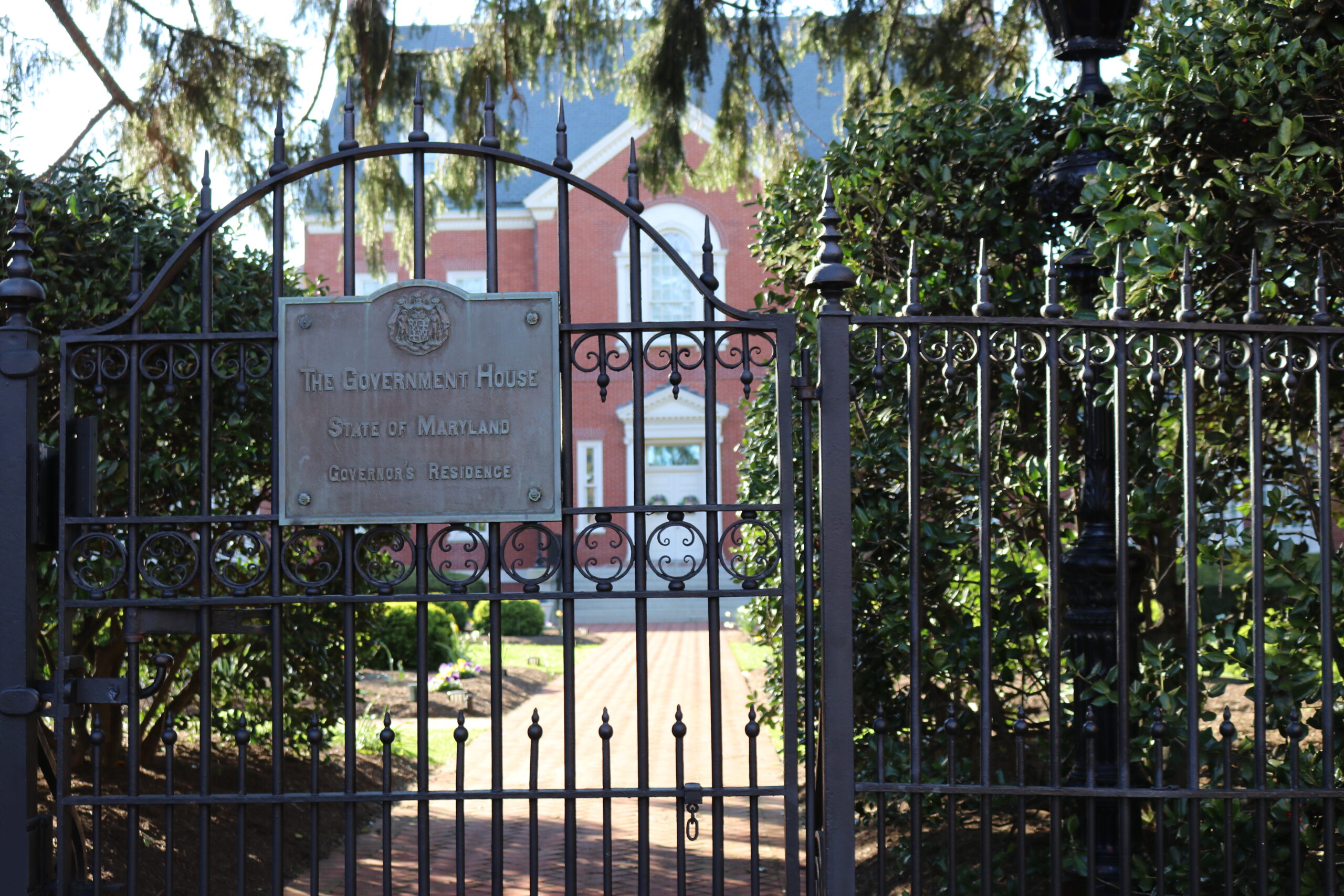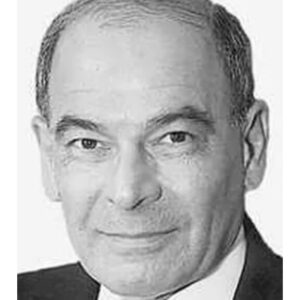Frank DeFilippo: The People’s House and a Really Big Deal

The following is adapted from my unpublished manuscript, Shiksa: The Rise and Fall of Marvin Mandel.
Whee, the people, have heard very little from the Hogans about the governor’s mansion, which is a good thing. Only recently they mentioned that the Big House would be open to the public, briefly, this past Saturday – a holiday tradition reborn.
And before that, there was a passing mention about the installation of a special appliance or two to accommodate the first lady’s heritage culinary tastes. And that’s about it.
The O’Malleys and the Erhlichs were reticent about their palatial lives, too. Each in their own way, they used the mansion smartly as a political tool, mainly as an encouraging setting for fundraising.
The Ehrlichs, Gov. and Mrs. Robert L. Jr., however, made a big deal of restoring the public rooms of the Georgian mansion to its period-piece authenticity. And at his inauguration, Ehrlich made a cringe-worthy jock-ish remark about having auditioned the bedding.
This time of year, however, the 54-room Big House in the gated circle in Annapolis becomes, if custom is followed, a decorator’s showcase, the centerpiece of official Maryland’s festivus and a winter showstopper for all who pass by. After all, it’s the people’s house.
But subtly and measured taste weren’t always watchwords involving the mansion.
If the state yachts were Gov. Marvin Mandel’s playthings, the mansion was Barbara Bootsie Mandel’s defense mechanism. She was so convinced that the official residence belonged to the people of Maryland that for six months she defiantly refused to surrender the mansion to her husband, Marvin, and her successor as chatelaine, Jeanne Blackistone Dorsey.
For over the years, the mansion has become the center of disputes as well as a metaphor for power. When Gov. William Donald Schaefer installed Maryland’s First Friend, Hilda Mae Snoops, as official hostess of Government House – oops, excuse the slip – the governor’s mansion, the first thing she did was to proclaim that the mansion “belongs to the people of Maryland.”
Patricia Hughes, wife of former Gov. Harry R. Hughes, a few years earlier, haughtily dismissed the décor of the Mandel-Lee years as “tacky” and rechristened the mansion as “Government House” with the proclamation that it “belongs to the people of Maryland.”
Jeanne Blackistone Dorsey Mandel, attempting to ease her entry into public life after years of rumors and romance in the shadows, announced to a reporter only hours after her hasty wedding to the governor that the “mansion belongs to the people of Maryland.”

Frank A. DeFilippo
Barbara Bootsie Mandel was so convinced that the residence belonged to the people of Maryland that she barricaded herself within its walls and refused to leave. Mandel complained then that the people of Maryland provide a residence for the governor and not necessarily for his spouse. To prove the point, he even had the law researched and the findings leaked to Bootsie.
Only Mimi Lee, who was installed briefly as interim first lady, truly believed that the Georgian mansion belongs to the people of Maryland. As far as she was concerned, they could have it, do anything they pleased with it except make her live in it.
Mimi Lee refused to have any identification with the mansion. She preferred the privacy and the easy comfort of the rambling Lee estate in Silver Spring. Mimi Lee spent most of her time wearing Sonny’s Surplus fatigues and teaching canoeing and swimming to Girl Scouts in Montgomery County instead of skulking the mansion’s cavernous rooms as a lonely prisoner in a long dress.
When Pat Hughes moved in, her instant assessment was “tacky.”
When Jeanne Dorsey, still unmarried to Mandel, moved into the mansion on the same day in December 1973 that Bootsie moved out, Marvin Mandel confided that Jeanne had spent hours “tearing the place apart and rearranging it.”
When Bootsie moved in, she said the mansion was run down and neglected. A real shonda. Even worse, the immediate past occupant, Spiro T. Agnew, had made off with the mansion bank account and all of the crystal except for several jelly glasses. Agnew also removed all of the wine from the cellar bins except one bottle of Manischewitz, perhaps his middlebrow idea of an ethnic joke.
Bootsie busied herself organizing the house to her taste. She ordered a new supply of matchbooks embossed in gold with the state seal and the words “Governor’s Mansion.”
“Government House sounds too much like a prison,” she said, even though that’s what the nameplate on the front gate read.
As a matter of record and observation, no one recalls a word, either pro or con, about the mansion from the mouths of Judy Agnew or Avalynne Tawes or Honolulu McKeldin. They were simple homebodies and happy wives who cared nothing about politics or attention and who had no need to use the mansion for other reasons.
Comes now Schaefer and friend who had just been given new authority over the mansion and one million freshly approved dollars to re-do what Pat and Harry Hughes spent $3 million and eight years doing, which won a picture spread in Architectural Digest.
The General Assembly had approved legislation that would transfer custody of the mansion’s public rooms from the Maryland Historical Society to a Governor’s Mansion Trust. And even before the changes and the budget were approved, Schaefer had ordered a $45,000 oriental carpet for the mansion’s grand foyer.
One of the first things Schaefer did upon taking office in January 1987, was to complain that Hughes had left the mansion’s household budget depleted. Schaefer was forced to secure an advance from the budget department to pay for his inaugural dinner. It was later discovered that Pat and Harry Hughes, just before turning the government of Maryland over to Schaefer, had used the remaining $6,000 in the mansion bank account to pay for alterations to their personal wardrobes.
There was ugly talk, too, that Harry and Pat Hughes had allowed many of the mansion’s one-of-a-kind pieces to be auctioned off as a way of raising money to buy furniture that fit the historic demands of the new period theme. No inventory or records exist.
During the 1987 session, a House of Delegates subcommittee toured the mansion and reported that it was in serious disrepair, especially the areas where the Hughes’ puppy was allowed to roam freely without benefit of paper training.
The persnickety Schaefer and Ms. Snoops were especially critical of the so-called Billy Baldwin room, done in the overstuffed style of the Maryland-born interior designer. To show their displeasure and disdain, they dismantled the room, put its contents in storage in the mansion basement and replaced them with electric trains at Christmastime.
During another holiday season, the room was used for an Easter egg hunt. The final tribute to Schaefer’s dubious taste was the Hilda Mae Snoops fountain that he had designed and installed on the mansion lawn. Schaefer, to be charitable, was Maryland’s king of kitsch.
Gov. Parris Glendening, Schaefer’s successor, later had the gurgling fountain turned off as a rebuke to Schaefer, in his new role as comptroller, who, in turn, leaked to the press Annapolis’ worst-kept secret, Glendening’s sideline romance with a much younger staff aide, whom he later married in what Shakespeare called a “plight troth,” after jettisoning his wife. The emergency wedding ceremony, of course, took place in the peoples’ house.
‘Look how much I’ve done for the mansion’
So why is the Governor’s Mansion or Government House or the Regal Residence or whatever it’s called, no longer just a big house but a very big deal? The imposing piece of brick real estate, encircled in its own fenced-in plot of grass across the street from the State House, is more than a tax-supported roof over the governor’s head. It has become a cornerstone of Maryland’s peculiar system of politics.
Government and politics is no 9-to-5 job. So the mansion provides convenient busy work for the resident first lady who, for the most part, is left husbandless – or friendless – to amuse herself for long and lonely hours of the day and night. Bootsie liked to say, “Look how much I’ve done for the mansion.” And she had.
Jeanne devoted as much of her puttering time to the mansion’s lawns and flower beds as she did to the interior of the house. A miracle of flowers took place with every change of season or bloom, all freshly installed, in full blossom, by agronomists from the state’s division of Buildings and Grounds at the expense of the budget of the Department of General Services. Another example of Jeanne’s handicraft involved ordering the walls of the mansion’s master bathroom covered with floor-to-ceiling mirrors. After all, the mansion belongs to the people of Maryland.
Jeanne’s indoor extravagance was reserved for the Christmas holidays, when commercial decorators were brought in to transform the mansion into a showcase for the ornament industry. The mansion belongs to the people of Maryland, and they had a chance to witness Jeanne’s holiday handiwork by attending the New Year’s Day open house, a custom that was later abandoned by the Hughes. And usually about 2,000 of the mansion’s owners turned out for a look. Schaefer and Ms. Snoops appeared to share Jeanne’s exuberance for Christmas decorations, not only in the mansion but in all state buildings whose occupants competed against each other with Schaefer as contest judge.
The official residence also supplies a handy public relations device that allows the first lady to put a smiley face on the family album. The merest whiff of rumor or gossip about the private difficulties of Maryland’s foremost public figures will produce the stock story about the governor’s mansion and Maryland’s First Decorator. It’s a human trumpet’s way of blaring to the world that all’s well in the Faerie Kingdom hard by the Bay in Crabtown, USA.
When Bootsie saw the mansion walls crumbling around her, she responded in the only way she could. She intensified activity in the big house, a frenzied rearguard action calculated to show that she was still its occupant and the governor was still by her side.
She ordered the printing of a mansion brochure that incorporated a picture of her and Governor Mandel. She increased the number of public tours from one to three afternoons a week. She inveigled a female television reporter to produce a half hour television documentary of her conducting a tour of the house and elaborating on points and objects of artistic and historic interest. The television show ended with the assignment of ownership, “The mansion belongs to the people of Maryland.”
Bootsie instituted a gallery of First Ladies to assure that her portrait would always hang in the majestic house. It was an ironclad clause in her divorce agreement. But when Jeanne took possession, she reversed the order and sent Bootsie’s portrait upstairs and out of view.
Bootsie disrupted the final day of the 1973 General Assembly session. Without the governor’s knowledge, she invited the wives of legislators to a sine die reception at the mansion. Imagine. Wives in Annapolis – in the mansion yet! – on the last of 90 days, the day reserved for unwinding and farewells. The mansion, after all, belongs to the people of Maryland, not to the wives of legislators.
Just as Bootsie, and later Pat Hughes, used the mansion to reinforce her position as first lady, Jeanne used the governor’s mansion to establish the fact that she was, indeed, first lady.
Jeanne used the mansion for lavish parties and continental meals of limited star ratings. She banished burgers and ketchup bottles, Mandel’s favorites, from the dining table and interposed in their place Veal Oscar and Bordeaux. And the place became a political clubhouse for her friends and relatives from St. Mary’s County. Mandel’s sidekicks from Baltimore complained that they were no longer invited to rub elbows with the high and the mighty at the mansion.
When Mandel married Jeanne Dorsey, he didn’t know an antique from an orange crate. Jeanne superimposed her tastes over those he had lived with for 30 years. Jeanne also ejected the State Police security force from its command post in the mansion’s ground floor and used the space to create a love nest of wicker and fern that resembled a Tiki bar.
The 1976 National Governors Association summer meeting took place in Hershey, Pa., in the heart of Pennsylvania Dutch country, a collective of craftsmen and woodworkers. During the meeting, Jeanne purchased so many pieces of furniture and antiques that a Maryland State Police truck had to be dispatched to ferry them back to Maryland and the mansion.
But Mandel was forced to surrender the governorship and move out of the mansion when he was sentenced to prison along with his five political pals. He was later accused by the state’s attorney general, Stephen H. Sachs – who was directed by Hughes (or more precisely Pat Hughes) to conduct an investigation – of taking with him thousands of dollars worth of furniture, food, liquor and dog food that belonged to the people of Maryland. Rather than contest the charges in court, Mandel quietly settled the grievance with a check for $9,000.
Then, after all of the commotion of the Mandel years, came the unkindest cut of all. Said Pat Hughes: “When we came here in January, 1979, we recognized that a lot had to be done. Not much attention had been paid to the house.”
‘It’s that damned mansion’
The Mandel divorce was as much a battle between one woman who wanted to move into the mansion and another who refused to move out as it was for the love of a man. As the months of Bootsie’s siege of the mansion dragged on, even Mandel observed:
“It’s that damned mansion. If it weren’t for the mansion this thing [the divorce] would have been settled long ago.”
In early England, peasants paid tribute to their sovereigns by kneeling and presenting peppercorns on Michaelmass Day. In modern Maryland, the mansion provides a convenient way for power brokers to buy into the political process. For example, the late James W. Rouse, the celebrated visionary developer, donated a $12,500 sterling silver service to the mansion while the Hughes were its occupants. (Hughes had authorized a network of roads and highways for Rouse’s new town of Columbia).
And later, W. James Hindman, the founder of Jiffy Lube and a friend of Schaefer, donated a $25,000 rug to the mansion just as he was preparing to bid on a $27 million state auto emissions testing contract. Others have sought the governor’s attention with hand-embroidered tablecloths and other bibelots fit for a governor and his lady.
Pat Hughes bluntly stated what her predecessors knew all along but had the grace not to mention because, after all, the mansion belongs to the people of Maryland. It is simply this: The mansion is a political weapon that can be used as leverage for or against a governor.




 Creative Commons Attribution
Creative Commons Attribution